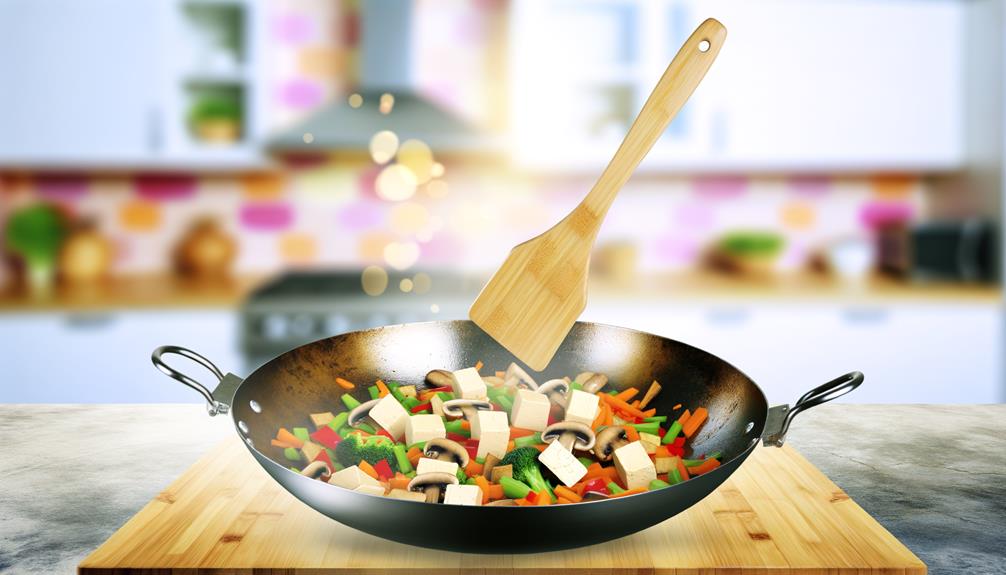Dancing flames cradle the wok, as you, the masterful chef, orchestrate a symphony of vibrant vegetables and tantalizing sauces. Your mission, should you choose to accept it, is to create the perfect animal-free stir-fry. It’s a culinary journey that requires finesse and a good understanding of technique. From selecting the right tools to nailing the heat and timing, every step is crucial. The satisfaction in tossing together a colorful medley of fresh produce, all sizzling in a deliciously aromatic sauce, is unparalleled. But how can you ensure each ingredient maintains its integrity, the flavors meld harmoniously, and your stir-fry isn’t a soggy mess? Well, let’s put on that apron and get to work. There are 15 key techniques waiting to be unraveled.
Key Takeaways
- Stock your pantry with essential Asian ingredients like soy sauce, oyster sauce, Shaoxing wine, toasted sesame oil, and rice vinegar. Consider adding gochujang for a spicy kick.
- Choose cooking oils with high smoking points, such as refined light olive oil or avocado oil.
- Invest in a quality wok with a lid for even heat distribution and versatile cooking methods. Use a wok spatula designed for easy stirring and tossing. Consider a carbon steel wok that is lightweight, heats quickly, and can be seasoned for better cooking performance.
- Achieve uniform ingredient sizes by cutting all ingredients into equal-sized pieces. This enhances the visual appeal and flavor balance of your stir-fry. Select cooking oils with high smoke points to prevent burning. Preheat your wok or pan on high heat for an authentic, smoky flavor. Spice up your stir-fry by adding aromatic ingredients like garlic, ginger, and scallions. Balance the five flavors of sweetness, sourness, saltiness, bitterness, and spiciness. Mix textures for interest by incorporating crunchy and tender elements. Perfect heat circulation techniques by preheating the wok, stirring and tossing constantly, and leveraging the wok’s shape for different heat zones. Experiment with different stir-fry sauces to enhance the flavor of your dishes. Infuse flavor with aromatic ingredients like sesame oil, garlic, ginger, and scallions. Marinate plant-based proteins to absorb flavors and achieve a blend of textures and flavors. Time your stir-fry ingredients properly by cooking ‘meat’ first, followed by ‘hard’ and ‘soft’ vegetables. Avoid overcrowding the wok to maintain high heat and enhance overall flavor.
Building Your Vegan Stir-Fry Pantry
To create mouthwatering vegan stir-fries, you’ll need to stock your pantry with essential Asian ingredients like soy sauce, oyster sauce, Shaoxing wine, toasted sesame oil, and rice vinegar. Don’t shy away from adding gochujang for those who crave a spicy kick. Having these essentials at your fingertips is key to making a stir fry that bursts with authentic flavors.
Next, consider your equipment. A carbon steel wok and a rounded spatula will become your best friends in the world of stir frying. They’ll help you cook your vegetables quickly and evenly, enhancing their natural flavors while preserving their crispness.
When it comes to preparation, it’s all about efficiency. Before you dive into your stir fry recipes, make sure to prep all your ingredients. This includes cutting them into uniform pieces and organizing your workspace for a smoother cooking process.
Choose cooking oils with high smoking points, such as refined light olive oil or avocado oil, to avoid burning your ingredients. Remember, overcrowding the wok can lead to steaming instead of stir frying, so cook in small batches. With these tips, you’ll master the art of vegan stir-fry in no time.
Essential Equipment for Stir-Fry
When you’re gearing up to perfect your stir-fry skills, investing in a quality wok, ideally with a lid, and a rounded wok spatula is a must. Your wok becomes the heartbeat of your kitchen, the vessel where all the magic happens. Using a wok not only lets you stir and toss your ingredients with ease, but it also evenly distributes heat for faster and more efficient cooking.
Consider a flat-bottomed wok made of carbon steel that’s adaptable to your heat source, be it gas, electric, or induction. Carbon steel is lightweight, heats up quickly, and can be seasoned for better cooking performance.
| Essential Equipment for Stir-Fry | Why It’s Essential |
|---|---|
| Wok with Lid | Ensures even heat distribution and allows for versatile cooking methods |
| Wok Spatula | Facilitates easy stirring and tossing |
| Carbon Steel Wok | Lightweight, heats quickly and can be seasoned |
| Bamboo Steamer | Allows for gentle cooking techniques often used in stir-fry |
Your wok spatula, ergonomically designed for the curves of the wok, makes stirring and serving a breeze. Finally, a bamboo steamer can enhance your stir-fry repertoire with gentle cooking techniques. With the right tools, you’re all set to stir up some delicious, animal-free stir-fry!
Pre-Cooking Organization Tips
Before diving into the energetic world of stir-frying, it’s crucial that you’re well-organized to make your cooking experience smoother and safer. Here are some pre-cooking organization tips to guide you:
- Create a Checklist: Before you start, ensure you have all the necessary ingredients for your stir-fry, from fresh vegetables to rice noodles. A checklist helps prevent any last-minute grocery runs.
- Preparation is Key: Wash, peel, and chop all your vegetables in advance. This ensures even cooking and streamlines the cooking process, allowing you to focus more on the stir-frying technique.
- Mise en Place: This French term means “everything in its place”. Arrange your ingredients, utensils, and cookware within easy reach. This technique makes the cooking process faster and more efficient.
- Clear the Area: A clutter-free cooking area allows you to focus solely on your stir-fry. Remove unnecessary items to promote safety and efficiency.
Achieving Uniform Ingredient Sizes
Diving into the art of stir-frying, it’s essential to understand the importance of achieving uniform ingredient sizes for even cooking and consistent texture. In the realm of Asian cooking, this technique is key for creating exquisite stir frys that are not only visually appealing but also full of wok hei, the coveted ‘breath of the wok.’
As home cooks, it’s simple to make this happen with a little attention to detail. Start by cutting all ingredients into equal-sized pieces. This ensures they cook at the same rate, preventing some parts from being overcooked while others are underdone. But remember, it’s not just about size. Consider the cooking times of each ingredient. For instance, quicker-cook items like bean sprouts or sugar snap peas can stay whole, as they’ll cook swiftly despite their larger size.
Achieving uniform ingredient sizes doesn’t just provide a well-cooked stir-fry. It also contributes to a richer, more balanced flavor, as each bite will contain the perfect blend of your ingredients. This technique takes your cooking from merely good to restaurant-quality, creating a pleasing eating experience for those you serve.
Choosing the Right Cooking Oil
In the world of stir-frying, choosing the right cooking oil isn’t just an afterthought; it’s a crucial aspect that significantly impacts the texture and flavors of your dish. The oil you select should have a high smoke point to prevent burning and ensure a successful stir-fry.
Here’s a quick guide to help you make the right choice:
- Avocado Oil: With a high smoke point, avocado oil is an excellent choice for your stir-frying needs. It’s light, neutral in taste, and won’t overpower your dish’s flavors.
- Rice Bran Oil: This oil also has a high smoke point, making it suitable for stir-frying. Plus, it’s packed with antioxidants and vitamins, adding a healthful boost to your meal.
- Grape Seed Oil: Another oil with a high smoke point, grape seed oil is also a good option. It has a mild flavor that blends well with most ingredients.
- Safflower Oil: With its light flavor and high smoke point, safflower oil is perfect for stir-frying. It helps enhance the taste of your ingredients without taking center stage.
Mastering High-Heat Stir-Fry
Now that you’ve chosen the right high-smoke point oil, let’s turn up the heat and master the art of high-heat stir-fry. A hot wok is crucial for successful stir fries. Preheat your wok or pan on high heat to get that authentic, smoky flavor. Ensure your kitchen setup can handle high heat and be prepared for some smoke.
Cut all ingredients into uniform pieces for even cooking. Remember, stir-frying is a fast process, so it’s essential to have everything ready before you start.
Avoid overcrowding your wok. Cook in small batches to maintain high heat. This prevents your ingredients from steaming and keeps them crispy.
Here’s a quick table to guide you:
| Step | Action | Tips |
|---|---|---|
| 1 | Preheat Wok | Use high heat |
| 2 | Prepare Ingredients | Cut into uniform sizes |
| 3 | Cook in Batches | Avoid overcrowding |
| 4 | Stir-Fry | Keep the ingredients moving |
| 5 | Serve | Enjoy while hot |
Mastering high-heat stir-fry is all about understanding your cooking oil, managing your wok’s temperature, and organizing your ingredients. It may take a few tries, but with practice, you’ll be stir-frying like a pro in no time!
Incorporating Aromatic Ingredients
Let’s spice up your stir-fry game by incorporating aromatic ingredients like garlic, ginger, and scallions. These ingredients are commonly used in Chinese cooking to infuse dishes with an irresistible depth of flavor. Here’s how to do it:
- Start your stir-fry with a splash of sesame oil. The heat from the oil will release the fragrances of your aromatic ingredients, adding depth to your dish.
- Add your aromatics. Garlic, ginger, and scallions are a traditional combination in Chinese food, but don’t limit yourself – shallots, lemongrass, or chili peppers can also add a unique twist.
- Let the aromatics sizzle in the oil for a minute or two to infuse their flavors into the oil. This forms the flavor base for your delicious stir-fry.
- Add your choice of vegetables and a splash of oyster sauce for that umami kick.
Incorporating aromatic ingredients is not just about adding flavor; it’s about creating an inviting, sensory experience. By mastering this technique, you’ll elevate your stir-fry dishes and impress those you serve. So go ahead, experiment with your aromatics and let your creativity run wild in the kitchen.
Marinating Plant-Based Proteins
Moving on to plant-based proteins, marinating them can significantly enhance the flavor and tenderness in your stir-fry dishes. As you prepare to marinate your meat substitute, it’s crucial to press tofu, ensuring it absorbs the flavors well, just like meat does in traditional Chinese cuisine.
Consider a marinade mix of soy sauce, mirin, garlic, and ginger. This combination adds depth, making your food stand out. The secret to a good stir-fry is letting your proteins sit in the marinade for at least 15-30 minutes.
However, don’t get stuck with one marinade recipe. Experiment with different flavors using ingredients like tamari, rice vinegar, and sesame oil. Let’s take a look at three of these marinades:
| Marinade | Ingredients | Marinate Time |
|---|---|---|
| Soy-Mirin | Soy Sauce, Mirin, Garlic, Ginger | 20 minutes |
| Garlic-Tamari | Garlic, Tamari, Olive Oil | 30 minutes |
| Sesame-Ginger | Rice Vinegar, Sesame Oil, Ginger | 15 minutes |
As you toss your cooked vegetables and marinated proteins around the pan, make sure you’ve achieved a blend of textures and flavors that will satisfy every palate at your table. Remember, the key to a successful plant-based stir-fry lies in the marinade.
Timing Your Stir-Fry Ingredients
Mastering the art of stir-fry is all about timing, as it ensures your ingredients cook evenly for a perfect blend of tender proteins and crisp vegetables. Timing your stir-fry ingredients properly is crucial to making stir-fry quick and easy.
Here are some steps to help you get it right every time:
- Start cooking the ‘meat’ first. In an animal-free stir-fry, this could be tofu or tempeh. These proteins often take longer to cook, and starting with them ensures they’ll be perfectly done when your vegetables are still crisp.
- Cook the ‘hard’ vegetables next. These are veggies like carrots or broccoli that take a bit longer to become tender. Add them after your protein has had a head start.
- Add ‘soft’ vegetables last. Things like bell peppers or zucchini cook quickly, so they go in last to prevent them from becoming too soft.
- Avoid overcrowding. This keeps your stir-fry from turning into a steamy mess and maintains the crisp texture you’re after.
Avoiding a Crowded Wok
Ensuring your wok isn’t overcrowded is a crucial part of successful stir-frying, helping to prevent your ingredients from steaming and instead promoting a crisp, evenly cooked result. Maintaining a good wok temperature is essential for proper stir-frying, and a crowded wok will quickly drop the heat, leading to soggy, steamed food instead of a delightfully seared dish.
When you’re stir-frying, always be mindful of the amount of ingredients you’re adding to your wok. Try to cook in small batches to ensure each piece of your ingredient gets equal exposure to the high heat. This method not only maintains the temperature of the wok but also enables you to move the ingredients around freely.
Remember, the amount of oil you use also matters. A crowded wok would require more oil, leading to excess grease in your dish. However, by avoiding an overcrowded wok, you’ll use less oil, keeping your stir-fry healthier and tastier.
Lastly, it’s key to cook your ingredients in the right order. Start with those that take longer to cook, and gradually add the quicker-cooking ingredients. This way, everything will be perfectly cooked and ready at the same time, enhancing the overall flavour of your animal-free stir-fry.
Balancing the Five Flavors
In the realm of stir-frying, balancing the Five Flavors – sweet, sour, salty, bitter, and spicy – is a culinary art, creating a harmonious taste experience you’ll savor with every bite. Professional kitchens often achieve this balance through careful choice and combination of ingredients, and you can too.
- Sweet: Add sweetness with sugar, fruits, or sweet vegetables. A dash of sugar or a smattering of ripe bell peppers can do wonders.
- Sour: Citrus juices or vinegar will bring that tangy sourness that can lift a dish and make it pop.
- Salty: Soy sauce or miso are excellent sources of saltiness, essential to round out the flavor profile of your food.
- Bitter and Spicy: Dark leafy greens introduce a bit of bitterness, while chili peppers or freshly ground peppercorns will provide that kick of spice.
Throughout the cooking process, adjust these flavors as needed. Taste your sauce as it simmers, add a bit more vinegar if it’s too sweet, or perhaps a sprinkle of salt if it’s too sour. Remember, the key to perfect stir-fry is in balancing the five flavors. With practice, you’ll be able to create a symphony of flavors that will have everyone asking for seconds.
Mixing Textures for Interest
Just as you’ve learned to balance flavors in your stir-fry, it’s equally vital to mix and match textures for an intriguing, satisfying bite. Mixing textures for interest can be achieved by incorporating a variety of crunchy, tender, and chewy elements.
Consider using a wooden spatula to stir-fry a combination of commonly used ingredients such as snap peas, bean sprouts, tofu, and seeds. These provide a satisfying crunch, while mushrooms and bell peppers add a tender bite.
Don’t be afraid to experiment with unexpected ingredients. Water chestnuts and bamboo shoots add a delightful crunch, while a cornstarch slurry can be used to create a glossy, thick sauce that coats every ingredient, enhancing the overall texture.
A mix of cooking techniques can also help to vary textures. Quick sautéing will keep your veggies vibrant and crisp, while a slower stir-fry might soften others for a pleasant contrast.
Perfecting Heat Circulation Techniques
Mastering heat circulation techniques in your stir-fry can make a world of difference in achieving that perfect, restaurant-grade flavor and texture. The way you handle heat can either make or break your dish. Here are some techniques to master:
- Preheating your wok: The first step is to ensure your carbon steel wok is hot enough. A high, hot heat is crucial. This guarantees a quick, even cook, sealing in the flavors and nutrients of your ingredients.
- Stir and toss constantly: Keep your ingredients moving. This prevents them from burning and ensures they cook evenly.
- Leverage your wok’s shape: The unique design of a wok allows for different heat zones. Move ingredients around to take advantage of this.
- Wok-tossing: This technique helps in perfecting heat circulation techniques. It allows your ingredients to gain equal exposure to the heat, enhancing their flavors.
Creating Delicious Stir-Fry Sauces
While mastering heat circulation techniques ensures your ingredients are perfectly cooked, it’s the art of creating delicious stir-fry sauces that truly brings your dishes to life. Start by experimenting with a variety of Asian sauces. Soy sauce, oyster sauce, and rice vinegar can really enhance the flavors of your stir-fry. Don’t shy away from fish sauce, either. It’s a secret weapon for adding depth and umami.
Aim for a balance of sweet, sour, salty, and spicy flavors. Mixing and matching sauces can help you achieve this. For a kick of heat, consider incorporating chile paste into your recipe. A dash of rice wine can add an unexpected sweetness that ties everything together.
When it comes to oils, both extra virgin olive oil and canola oil are excellent choices for creating stir-fry sauces. Remember, it’s all about balance. Experiment with these oils until you find the perfect ratio that appeals to your taste buds.
Lastly, don’t forget the finishing touch: a drizzle of unrefined sesame oil. This will add a nutty, aromatic flavor that elevates your stir-fry to new heights. Personalize your sauce by adding ingredients like garlic, ginger, and chili for extra depth.
Enhancing Stir-Fry With Accompaniments
Once you’ve mastered the art of crafting a sublime stir-fry sauce, it’s time to elevate your dish further with the right accompaniments. When it comes to stir-frying, it’s not just about the veggies and sauce; it’s about complementing them with the perfect extras.
Here’s a 4-item list to guide you:
- Including Rice: A stir-fry isn’t complete without rice. Whether it’s jasmine or basmati, rice adds a hearty base to your meal. It’s an absolute must when it comes to making a well-rounded stir-fry.
- Noodles: Another great accompaniment to consider are noodles. From soba to ramen, noodles can add a delightful texture to your dish.
- Sauces and Spices: Stock up on essential ingredients like soy sauce, oyster sauce, and gochujang. They’ll add an authentic taste and a spicy kick to your stir-fry.
- Preparation: Preparation is key. Before you start cooking, make sure you’ve got all the ingredients you need. It’ll make the process much smoother.
With these techniques, you’ll master the art of animal-free stir-fry in no time. It’s all about balance and harmony in your dish. So go ahead, stir-fry your heart out!
Frequently Asked Questions
What Is the Secret to a Successful Stir-Fry?
You’ll master stir-fry by selecting vibrant vegetables, choosing high-heat oils, following a proper frying sequence, enhancing flavors with sauces and spices, preparing tofu correctly, and managing heat to ensure everything’s cooked to perfection.
What Are the 3 Rules of Stir-Frying?
You’ve gotta remember three key stir-fry rules: always start with a hot wok and cold oil, keep your ingredients dry, and cut them uniformly. It’s like choreographing a dance – precision and timing are crucial.
How Do You Make Stir-Fry Like a Pro?
You’ll master stir-fry like a pro by choosing vegan alternatives, perfecting ingredient selection, nailing stir-fry timing, experimenting with flavor combos, selecting the right utensils, and presenting it with stylish serving suggestions. It’s all about practice and patience.







